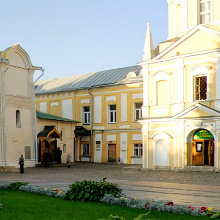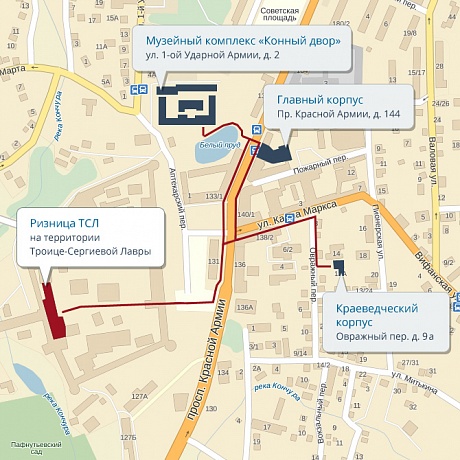
The Sacristy branch
Exposition: The Sacristy of the Trinity-St. Sergius Lavra of the 11th - 17th cc.
The exhibition is open to single visitors (from 1 to 15 people) and for combined groups with guided tours (from 5 to 11 people) for a session.
Session duration - 45 minutes
Wednesday – Sunday from 10.00 to 18.00.
self-guided sessions: 10.00/ 10.30/ 11.15/ 12.00/ 14.00/ 14.30/ 15.15/ 16.30/ 16.45
guided tour sessions: 10.15/ 10.45/ 14.15/ 14.45/ 16.00
Order of excursions: +7 (496) 540-53-56
History of the Sacristy
The Museum collection of ancient Russian art "The Sacristy of 14th – 19th centuries" is one of the most significant collections in our country. It is based on the historically accumulated treasures of the Trinity- St. Sergius Monastery of the 14th - 19th centuries. The exhibition is situated within the walls of the ancient Monastery, in its historical place - in the building of the Monastery Sacristy and the Vicegerent Chambers. For centuries there were concentrated rare and unique monuments: icons, manuscripts and old printed books, icon and ornamental embroideries, objects of gold and silver. They were donations of grand and apanage princes, Russian tsars and emperors, of noble families and representatives of various layers of Russian society. The Sacristy exhibition demonstrates a high level of Russian artistic culture in medieval and New time periods.
The most valuable collection is housed in the building of the Sacristy, constructed in 1782, and partially in the Vicegerent Chambers. In December 9, 1780, when the old Sacristy Chambers decayed, Archbishop Platon (Levshin) wrote a letter to the State Collegium of Economy, informing that “…such sacristy chambers are required to store different precious church utensils, as there is no other convenient building to place and preserve them. Considering the situation and informing the State Collegium of Economy
I ask to regard the possibility to go to the expense of the repairs and to determine the sum that could be provided; the plans and cost account appended”. The response to Platon’s request was “ Her Majesty the Empress ordered to provide the Lavra with the sum of 8 112 rubles for the construction of new chambers for the sacristy articles on the site of the decayed building”.
In September, 1872, the new Sacristy was built. In September 16, 1782, the ensign of architecture Nikolai Adoyevtsev reported that “the whole structure was made by the builders precisely according to the plans, no faults were found out”. The manuscript of 1785, describing the new Sacristy runs: “To the west of the Trinity Church stands the recently constructed vestry wing, three-storied, with five summer and winter cellars in the ground floor; eight cells for sextons and a sacristan, two mud rooms and two store rooms in the middle floor; five chambers for the sacristy items and a mud room in the upper floor, covered with an iron roof. This wing is 23 Russian fathoms (161ft) long, 4 Russian fathoms and 4 arsheens (28 ft and 112 in) wide”.
The materials are from the Russian State Archive of Ancient Acts (RSAAA). Fund 1204. Description. 1. File 913 (1780).









